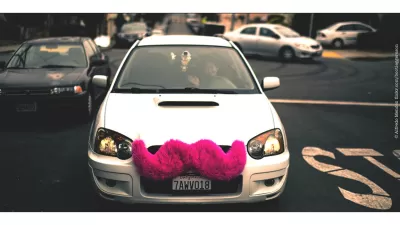Ride-hailing services have already conquered center cities, with companies like Uber and Lyft changing the landscape for commuters, visitors, and late-night revelers alike. The next challenge: solving the suburban-to-urban commute.

For all the attention ride-hailing has received over the past year or two, the vast majority of travelers in cities do not commute, do errands, and go out via smart phones and anonymous drivers. Those who are most bound to old-fashioned private automobiles are residents of suburban areas, which, by most accounts, are not dense enough and too far-flung to support the swarm of ride-hailing cars that make them so convenient in cities.
But, as ride-hailing becomes more commonplace and the major companies continue to add drivers and hone their strategies, the idea of replacing a punishing commute with a leisurely passenger trip is becoming more viable.
"The two major ride-hailing services are famously secretive about their data and business practices, so their prevalence in the suburbs is difficult to quantify. Anecdotally, their presence is growing, and it seems to be doing so organically. Both companies have followed remarkably fluid—some would say too fluid—business models that have enabled the companies’ driver-entrepreneurs, who are typically private contractors who drive their own vehicles and work according to their own schedules, to meet demand nearly wherever it arises. Ride-hailing is so appealing to some suburbs, in fact, that some suburban governments have actively welcomed the services."
Ride-hailing services can not only drive passengers all the way to the office and back. They can also serve as crucial links in the "first mile, last mile" problem that makes it difficult for suburbanites to use public transit, such as commuter rail, even when those services are geographically nearby.
For all their potential benefits, some see a growing rivalry between blatantly capitalist ride-hailing services and mission-driven services that exist to ease commutes and provide what advocates refer to as "true" ride-sharing services.
"The shiny, hip appeal of the major ride-hailing services has brought about what many in the media are heralding as a “ride-sharing revolution.” But some mobility advocates insist that these services are not revolutionary—and they’re actually not ride-sharing either. Whereas Uber and Lyft are largely urban creations, “true” ride-sharing—from nonprofit local transportation management associations (TMAs) and companies such as Carma, Sidecar and Flywheel (see sidebar), most of which operate in a limited number of markets—is a creature of the suburbs."
"Purists who support ride-sharing contend that the services differ in a crucial way: ride-sharing drivers, and the companies themselves, are not necessarily motivated by profit. They seek to match drivers and passengers for the sake of a social mission—mobility, environmental protection and cost savings. A driver who makes his passenger seat available and gets a break on gas and tolls is one thing. A driver who is trying to make a living is something else. Uber and Lyft are designed to indiscriminately pick up fares whenever and wherever they can."
FULL STORY: Ride-Hailing Apps Go the Extra Mile

Planetizen Federal Action Tracker
A weekly monitor of how Trump’s orders and actions are impacting planners and planning in America.

Congressman Proposes Bill to Rename DC Metro “Trump Train”
The Make Autorail Great Again Act would withhold federal funding to the system until the Washington Metropolitan Area Transit Authority (WMATA), rebrands as the Washington Metropolitan Authority for Greater Access (WMAGA).

The Simple Legislative Tool Transforming Vacant Downtowns
In California, Michigan and Georgia, an easy win is bringing dollars — and delight — back to city centers.

Albuquerque’s Microtransit: A Planner’s Answer to Food Access Gaps
New microtransit vans in Albuquerque aim to close food access gaps by linking low-income areas to grocery stores, cutting travel times by 30 percent and offering planners a scalable model for equity-focused transit.

This City Will Pay You to Meet Your Neighbors
A North Kansas City grant program offers up to $400 for residents to throw neighborhood block parties.

Commentary: Our Silence Will Not Protect Us
Keeping our heads down and our language inoffensive is not the right response to the times we’re in. Solidarity and courage is.
Urban Design for Planners 1: Software Tools
This six-course series explores essential urban design concepts using open source software and equips planners with the tools they need to participate fully in the urban design process.
Planning for Universal Design
Learn the tools for implementing Universal Design in planning regulations.
Smith Gee Studio
City of Charlotte
City of Camden Redevelopment Agency
City of Astoria
Transportation Research & Education Center (TREC) at Portland State University
US High Speed Rail Association
City of Camden Redevelopment Agency
Municipality of Princeton (NJ)




























